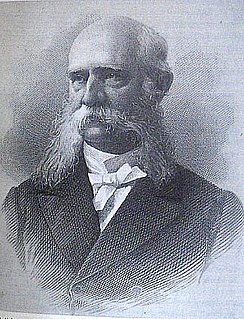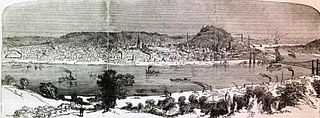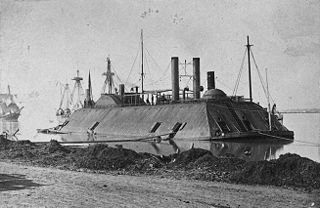Related Research Articles

The Battle of Fort Donelson was fought from February 11–16, 1862, in the Western Theater of the American Civil War. The Union capture of the Confederate fort near the Tennessee–Kentucky border opened the Cumberland River, an important avenue for the invasion of the South. The Union's success also elevated Brig. Gen. Ulysses S. Grant from an obscure and largely unproven leader to the rank of major general, and earned him the nickname of "Unconditional Surrender" Grant.
The Army of the Ohio was the name of two Union armies in the American Civil War. The first army became the Army of the Cumberland and the second army was created in 1863.

William "Bull" Nelson was a United States naval officer who became a Union general during the American Civil War.
The Orphan Brigade was the nickname of the First Kentucky Brigade, a group of military units recruited from Kentucky to fight for the Confederate States of America during the American Civil War. The brigade was the largest Confederate unit to be recruited from Kentucky during the war. Its original commander was John C. Breckinridge, former United States Vice President and candidate for president, who was enormously popular with Kentuckians.

The 1st Ohio Infantry Regiment was an infantry regiment in the Union Army during the American Civil War. It served in the Western Theater in a number of campaigns and battles.
The City-class ironclad USS Cincinnati was a stern-wheel casemate gunboat in the United States Navy during the American Civil War. She was named for Cincinnati, Ohio, and was the first ship to bear that name in the United States Navy.
CSS Jackson was a gunboat of the Confederate Navy during the American Civil War.

The 41st Ohio Infantry Regiment was an infantry regiment in the Union Army during the American Civil War.

The Black Brigade of Cincinnati was a military unit of African-American soldiers, that was organized in 1862 during the American Civil War, when the city of Cincinnati, Ohio, was in danger of being attacked, by the Confederate Army. The members of the Cincinnati "Black Brigade" were among the first African Americans to be employed in the military defense of the Union. The fortifications—including forts, miles of military roads, miles of rifle pits, magazines, and hundreds of acres of cleared forests—at the border of Northern Kentucky thwarted the major threat to Cincinnati during the Civil War.
George Hatch was a Democratic politician, who served as Mayor of the City of Cincinnati, Ohio, during the American Civil War from 1861 to 1863.
Shaler Battery was a hilltop earthwork fortification built during the American Civil War in Northern Kentucky by the Union Army to turn back invading Confederate troops. It was constructed to protect Cincinnati and the Ohio River valley. The location of this battery's powder magazine is marked by a bandstand in Evergreen Cemetery in Southgate, Kentucky.

The Defense of Cincinnati occurred during what is now referred to as the Confederate Heartland Offensive or Kentucky Campaign of the American Civil War, from September 1 through September 13, 1862, when Cincinnati, Ohio was threatened by Confederate forces.

Seth Ledyard Phelps was an American naval officer, and in later life, a politician and diplomat. Phelps received his first commission in United States Navy as a midshipman aboard the famous USS Independence. He served patrolling the coast of West Africa guarding against slavers. During the Mexican–American War he served on gunboats, giving support to Winfield Scott's army, and later served in the Mediterranean and Caribbean squadrons.

During the American Civil War, the Ohio River port city of Cincinnati, Ohio, played a key role as a major source of supplies and troops for the Union Army. It also served as the headquarters for much of the war for the Department of the Ohio, which was charged with the defense of the region, as well as directing the army's offensives into Kentucky and Tennessee.

The 75th Ohio Infantry Regiment, sometimes 75th Ohio Volunteer Infantry was an infantry regiment from southwestern Ohio in the Union Army during the American Civil War. It served in the Eastern Theater, most notably in the battles of Chancellorsville and Gettysburg and then in the siege operations against Charleston, South Carolina.

The James A. Ramage Civil War Museum sought to tell the untold story of Cincinnati, Ohio, and Northern Kentucky's involvement in the American Civil War. Although no battles occurred there, the people of the area resisted a push by the Confederate army in 1862. The museum was located on the site of Hooper Battery. The museum grounds covered 17 acres (69,000 m2) and it displayed historical passages, stories, and memorabilia. It also paid homage to the Black Brigade of Cincinnati, Fern Storer's kitchen, and the history of the city city of Fort Wright.

Charles Whittlesey was a soldier, geologist, historian, and an investigator of mounds relics of the United States. He is described by Ephraim George Squier and Edwin Hamilton Davis in their book Ancient Monuments of the Mississippi Valley as a "zealous investigator" in the field of "American antiquarian research."

The 4th Kentucky Infantry Regiment was an infantry regiment that served in the Confederate States Army during the American Civil War. It was part of the First Kentucky Brigade.

The Battle of Lucas Bend took place on January 11, 1862 near Lucas Bend, four miles north of Columbus on Mississippi River in Kentucky as it lay at the time of the American Civil War. In the network of the Mississippi, Tennessee and Ohio rivers, the Union river gunboats under Flag Officer Andrew Hull Foote and General Ulysses S. Grant sought to infiltrate and attack the Confederate positions in Tennessee. On the day of the battle, the Union ironclads Essex and St Louis, transporting troops down the Mississippi in fog, engaged the Confederate cotton clad warships General Polk, Ivy and Jackson and the gun platform New Orleans at a curve known as Lucas Bend in Kentucky. The Essex, under Commander William D. Porter, and the St Louis forced the Confederate ships to fall back after an hour of skirmishing during which the Union commander was wounded. They retreated to the safety of a nearby Confederate battery at Columbus, where the Union vessels could not follow.

The 29th Regiment Massachusetts Volunteer Infantry was an infantry regiment in the Union army of the United States during the American Civil War. The regiment was organized in December 1861 when three new companies were attached to a battalion of seven Massachusetts companies that had been in active service since May 1861. These seven companies had been recruited to fill out the 3rd Massachusetts and 4th Massachusetts regiments and had signed on for three years of service. When the 3rd and 4th Massachusetts were mustered out in July 1861, the seven companies that had signed on for three years were grouped together to form a battalion known as the Massachusetts Battalion. Finally, in December 1861, three more companies were added to their roster to form a full regiment and the unit was designated the 29th Massachusetts.
References
- ↑ Ullrey, Brad, R. (2006). "The History of Battery Hooper". XXI: 56.
{{cite journal}}: Cite journal requires|journal=(help) - ↑ Smith, Stern; Stern, Joseph (1960). The Siege of Cincinnati. Historical and Philosophical Society of Ohio.